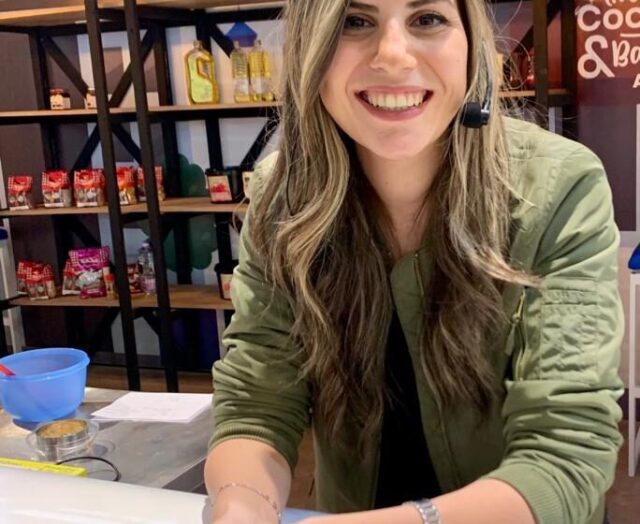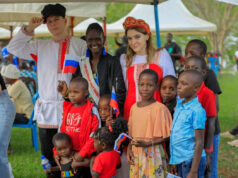
By Lara Reffat
Sarah Magdy starts off one video with the announcement that she’s a millionaire. But it’s not what you think. She then holds up some cash and explains that it’s actually 3 million Lebanese Lira- that’s just shy of $2000. What comes next is a crash course on currency power and some insight into Lebanon’s dire economic state.
Scroll down a little further and you get a bite-sized lesson on superhero propaganda. Magdy invites commenters to share their thoughts on the potential influence of an Israeli superhero.
But it’s not all world issues and heated debates. Magdy also touches upon lighter topics. She makes no secret of her love of food and travel. Followers are invited on these adventures and often suggest famous dishes and hidden gems. Through her account, Magdy has become Egypt’s first Tiktok journalist.
Infotainment
Journalistic mediums have evolved over the years. TikTok journalism is the latest development in the industry. Sarah Magdy spoke with AWiM News about discovering her niche on Tiktok and the journey so far.
Magdy always knew she would be working in the media. She loved multimedia journalism and even pursued a master’s degree in the subject. Soon, Magdy embarked on a career making documentaries and programmes.
“It wasn’t long until I realised that I have a real passion for video and filmmaking.”
She had her lightbulb moment in 2020.
Like the rest of the world, the lockdown meant more time at home and online. Everyone was talking about TikTok. She’d see people sharing a day in their quarantine life or just passing the time. Even celebrities were getting in on the trends and dance challenges.
“It was interesting to see the rise of the app during that time and the insane amount of time people – me included- spend scrolling Tiktok’s FYP (for you page).”
Magdy noticed that Arab businesses and advertisers were on the app, but there wasn’t an active Arab journalist in sight.
“I tried to understand its perplexing algorithm. I was told that TikTok is a dancing app for teenagers while in fact, it’s the most downloaded app in the world with over 1 billion active users.”
She was motivated rather than deflated by her beginner’s status. There was nowhere to go but forward.
“I started with zero followers and no one I knew was on the app and that encouraged me to throw a random stone and watch it roll. I had nothing to lose.”
Magdy quickly noticed the content and style that clicked for her followers. It was her cue to continue in that direction, yet still, shake things up.
“I remember the series I did right after the Beirut Port explosion was the beginning. I used my profile to update people with the news and explained what happened in a series of videos, and people started to interact very well with that.”
When she was just starting, TikTok users guided her with some dos and don’ts of the app. And one word was at the centre: “infotainment”.
On TikTok, even news is rarely ever delivered as a straightforward broadcast. Softer stories may use memes or take note of the latest trend. But even hard news cannot afford a moment of dullness. It has to be punchy enough to reel viewers in and compelling enough to leave them wanting more.
“Information and facts are read on the news as they are but on social media, you probably need to come up with a sketch or a relatable meme to hook people to watch/ listen to the same piece of info…And that all should happen in a few seconds. Otherwise, they will simply scroll down to endless possibilities.”
Though social media news has been around for a while, as the medium has grown videos have gotten shorter. While content creators on YouTube and Facebook can create videos that easily exceed two hours, TikTokers don’t have that kind of time.
Tiktok is an app that powers off of liveliness and energy, and that’s what Magdy put her cards on.
“I used text on screen, filters, photos, green screen effects and memes.. people on this app love memes and challenges, it makes the content fun and relatable at the same time. I am also still exploring new ways and styles,” she said.
Gender and journalism
Though Magdy and other journalists are increasingly using social media, female journalists continue to face rampant online abuse.
In 2016, the Guardian conducted a study of 70 million comments on their website. It found that “of the 10 most abused writers, eight were women.” Many of the comments hurled abuse including threats of death and rape.
These incidents are not restricted to one newspaper or region and abuse often also has racist and xenophobic undertones.
A 2021 paper by UNESCO examining online abuse of female journalists further noted some of these trends. As part of the study, the researchers surveyed 901 female journalists on how cases of online abuse can shift offline.
“Over half (53 per cent) of the women identifying as Arab said they had experienced offline attacks they think were seeded online, compared to 11 per cent for white women and 20 per cent overall,” the study found.
Comments on TikTok can be particularly scathing as the medium is highly visual. Content creators are more exposed and therefore more vulnerable to their followers. And when subjects are controversial, fierce backlash and abuse increase.
“Some people just come to my profile to ask me to cover my hair, and body or go do the housework ‘because that’s what women should be doing.’”
The interactivity that social media offers simply does not exist with more traditional mediums and Magdy manages her expectations.
“Interactivity is a double-edged weapon; it can massively add to your content and help you build a valuable loyal community but it can also take from your energy and break you into shreds.”
But it’s not just the increased interactivity that Magdy has been exploring. Social media also gives her more freedom as a journalist. With her page, Magdy seeks out her opportunities and makes the most of them.
Looking back at her experience in traditional journalism, Magdy knows editors wouldn’t assign her to certain locations or to topics that were “too risky” for a woman.
“On social media, I am my own editor and people’s reaction and interaction are the only measurements to the success of my content and abilities.”
Perhaps the most exciting theme on Magdy’s channel is taking conversations common in the western side of social media into Egyptian contexts.
“I already spoke about some sensitive topics on my platform like period poverty, sexual harassment, and gender-based discrimination and these topics are unheard of on Egyptian TikTok.”
The two-way nature of social media means that along with building connections with followers, she’s picked up on key patterns of common attitudes.
“I got enormous support from some people and a backlash from others who think these topics are taboos and that we have more important problems to talk about! You definitely can’t change how people think overnight but the way issues are presented and portrayed plays a massive role in how people perceive it.”
Magdy focuses on what she does have control over. When creating content she values three words: “preparation, presentation and representation.”
This article is part of the African Women in Media (AWIM) Graduate Trainee Programme in collaboration with Fojo Media Institute













